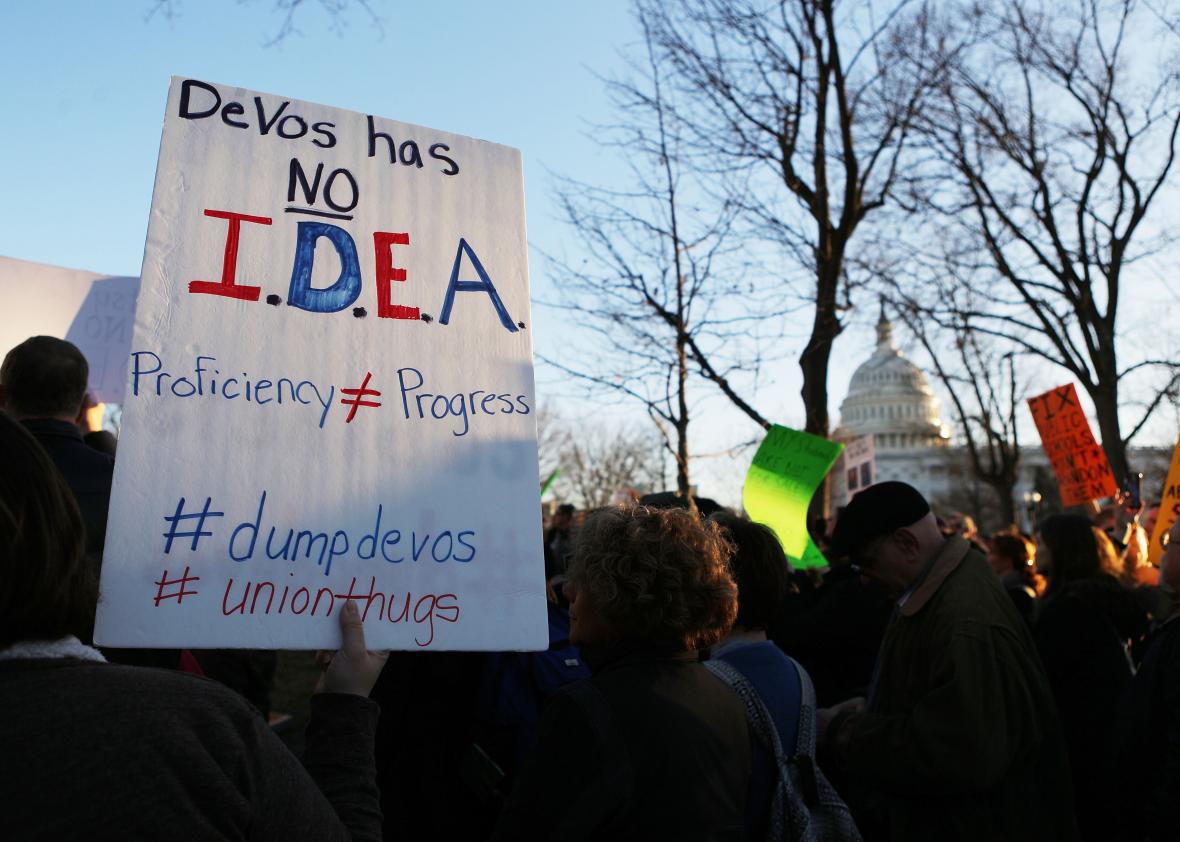Is This Normal? is a Slate series that attempts to determine which controversial Trump World behaviors are outrageously unprecedented, which are outrageous but within the realm of what others have gotten away with, and which shouldn’t be considered outrageous at all.
The Issue
The Washington Post reported last week that the Education Department is currently paying the U.S. Marshals Service nearly $1 million a month to protect Secretary Betsy DeVos, a significant step-up in security services for a Cabinet post that had previously relied on a small team of in-house civil servants for job. The New York Times reported on Monday that U.S. EPA Administrator Scott Pruitt has requested around-the-clock protection, which would be a first for an EPA chief and could require hiring 10 additional full-time employees for the job.
Federal agencies don’t discuss the specifics of their internal security protocols for operational reasons, but these two reports provide anecdotal evidence that members of Trump’s Cabinet—not unlike the president and his family—are requiring unprecedented levels of security.
Is this normal?
The Precedent
It’s not unusual that senior Trump officials have their own security details. Top executive branch officials have had their own government-funded protection—ranging from an occasional escort for a public appearance to 24/7 personal security—since at least the 1970s. Typically, the safekeeping of a secretary is the responsibility of their own department’s internal enforcement or investigative division. The FBI, for instance, protects the attorney general, the U.S. Park Police covers the secretary of Interior, the EPA’s Office of Criminal Enforcement runs point for the EPA administrator, and so on. The fact that men and women with earpieces are shadowing some members of Trump’s Cabinet is not unusual. A better framing of our question, then, is not whether it is normal that U.S. taxpayers are footing the bill to keep DeVos, Pruitt, & co, safe, but whether that bill is abnormally large.
On this question, the specifics are frustratingly difficult to come by. The government typically tries to obscure those numbers in order to avoid tipping off a would-be assailant as to what to expect. And the internal divisions that provide the security have other responsibilities—the EPA officials that protect Pruitt, for example, are also tasked with investigating environmental crimes—so there is rarely one single line-item in the budget to compare from year to year.
The limited information we do have, though, suggests that the price of protecting Cabinet members and other senior government officials has been on the rise since well before Trump took office. The Government Accountability Office, at the urging of Congress, has investigated the cost of protecting executive branch officials several times over the years. The last time the GAO crunched the numbers was 2000 making the data more than a bit dated. Still, the trend at the time was hard to miss.
The annual combined totals of the ten departments the GAO surveyed in 1994 increased in each year of a three-year stretch, from $1.5 million in 1992 up to $2 million in the first nine months of fiscal 1994. The upward trend was even more pronounced six years later when the GAO cast its net wider: The 27 different agencies it surveyed then reported a 49-percent increase in costs for protecting senior officials over the preceding three years, from $19.1 million in 1997 to $28.5 million in 1999. And that was before 9/11 drastically accelerated the speed at which the nation’s security state expanded.
The Verdict
The fact that Trump’s Cabinet officials have their own personal security details is Normal, as is the fact that the level of security being provided to at least some Trump officials is above and beyond what was given to their respective predecessors.
None of that changes the infuriating reality that the Trump administration is spending money to beef up the protection of its own top officials as it simultaneously attempts to cut spending drastically for carrying out the important missions of those same governmental agencies. Even so, it’s worth remembering that money spent on the former is but a drop in the bucket compared to the latter. The Education Department, for example, will reportedly pay the U.S. Marshals nearly $8 million over an eight-month stretch this year to protect DeVos from threats and protestors. Trump, meanwhile, wants to cut the annual budget of the department Devos oversees by about $9 billion. So focusing your anger at DeVos’s security expenditures would be like saying Kevin Costner’s post-The Bodyguard career would have been totally fine if he had never made Draft Day, while completely ignoring the existence of Waterworld, The Postman, and all those other box-office flops he made. It just doesn’t make sense.
